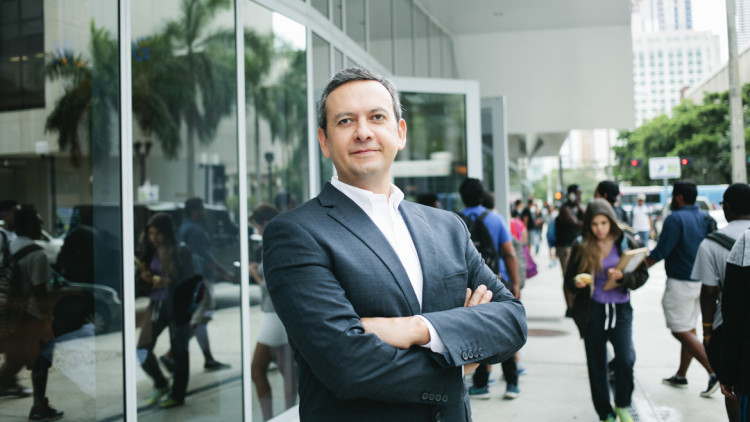“Conversations” is an ongoing series of talks with thinkers, leaders and supporters of the MDC Community.
A Loeb Fellow from the Harvard Graduate School of Design, Ramiro Almeida recently spent three years as Visiting Scholar at the MIT Media Lab. At MIT, he conducted research on innovation in the areas of urban transformation, technology and entrepreneurship. MDC has invited Almeida to serve as the Idea Center’s Professor in Residence, where he will teach the Innovation Lab’s inaugural class.
Gabriel Riera: What is human centered design?
Ramiro Almeida: This holistic approach to design takes inspiration from real people, works within market and technological constraints, and considers every product or service touchpoint as an opportunity to disrupt, surprise, delight and deliver benefits to users.
The process usually involves asking the right questions, going out and interacting with as many people as possible, getting user feedback constantly, extensive team work and building minimum viable prototypes as early as possible. There are many useful online tools available to get familiar with the process: usertesting.com, getsatisfaction.com or verifyapp.com offer good resources to start testing your ideas.
“My entire conception of higher education was transformed from that very moment.”
GR: How has your experience at MIT shaped your teaching methods?
RA: The first class I attended at MIT before my appointment at the Media Lab is called Development Ventures, taught by Sandy Pentland and Joost Bonsen. Sandy is considered the godfather of wearable computing, including the preliminary designs for what was later known as Google Glass.
The introduction to the class was something like this: “We need you to come up with a product or service that will provide enduring and economically viable solutions to problems faced by at least one billion people worldwide.” My entire conception of higher education was transformed from that very moment. MIT provided me with the liberty to take chances and explore different methodologies to create lasting academic experiences for students.
GR: What do you mean when you talk about ventures that are “resilient?”
RA: In today’s rapidly changing world, we need to be able to adapt early and fast enough to survive and succeed. These concepts revolve around the early stage of a project, as part of a Design Thinking process and methodology where you come up with ideas that are flexible and elastic. Part of the effort is to look at a specific set of problems from every angle and do as much research and exploration as possible to come up with the best alternatives to create something that can be modified over and over again. We can’t predict the future, but we can plan and control how we respond to the constant challenges of our world and transform them into opportunities for growth.
GR: What do you want to communicate to students who take your class?
RA: The class revolves around three concepts: creativity, innovation and design. The class is designed to provide students with a broad and general understanding of the changing world around us and to be able to reflect and explore upon what technology is doing to our everyday lives. We create a laboratory type of experience that enables students to think through their ideas thoroughly, learn about platforms and technological tools that can provide them with better opportunities, and point their interests and careers to paths that carry relevant options and plenty of potential towards the future.
“We will engage students in breaking some of the traditional education models…”
GR: How is this class different from a standard class at MDC or another college?
RA: The main difference revolves around the class experience. The course presents real life cases of innovation that have transformed the way we live, work, learn and play. We will expose students to these concepts through guest speaker lectures, field trips, hands on exercises and video feeds. We will engage students in breaking some of the traditional education models by generating fun educational experiences, collaborating in new ways inside and outside the classroom, and encouraging exploration and daily research activities.
GR: Why is learning to identify relevant problems important — aren’t problems obvious?
RA: Problems are not obvious. Each human being has a very specific and different way to approach them. Society sometimes leaves out all the problems that we don’t bother changing because we’ve stopped seeing them as solvable. We’ve accepted them as part of the way our world works, and don’t even think about what to do to relieve them. Or we just never saw them in the first place. Reflecting on ways to identify relevant problems is essential for students. Problems don’t just disappear. In fact, they tend to grow in severity the longer they’re ignored. Having the capacity to identify them early according to specific sets of needs or challenges can provide students with better chances for success.
GR: Is it possible to “teach” creativity?
RA: We can provide students with a wide variety of resources to help them develop techniques to approach creation and design in a number of ways and according to their specific interests. We will be exploring the potential to foster creativity through education and the exposure to various platforms and training, especially as augmented by technology. We will interact with diverse sources of inspiration from our community. Our main goal is to engage students in the creative process by providing them with an appropriate learning environment in our classroom.
Course Details:
ENT2612: Creativity, Innovation and Human Centered Design
Reference Number: 897417
Sept. 29 to Dec. 15, 2015
Tuesdays/Thursdays Time: 9:50 – 11:30 a.m.
The Idea Center at Miami Dade College – Room 8510
Wolfson Campus, Downtown Miami
